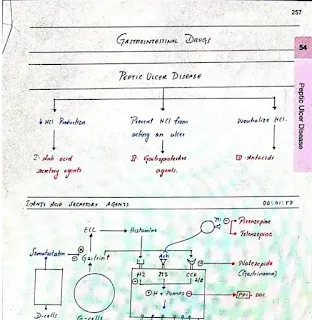Download PDF Notes & PPT: Gastrointestinal Drugs
Discover essential study materials on Gastrointestinal Drugs. This resource, available as a downloadable PDF, is perfect for students and healthcare professionals learning about medications for the digestive system. You'll find clear notes and potentially PPT (PowerPoint Presentation) summaries to support your studies.
Easily download these notes for offline access or view the document online. Get a comprehensive overview of various classes of GI drugs, their mechanisms, uses, and important considerations for treating conditions like acid reflux, ulcers, constipation, diarrhea, and nausea.
Keywords for this resource:
Download PDF, Pharmacology Notes, GI Drugs, Gastrointestinal Medications, Digestive System Pharmacology, Antacids, PPIs, H2 Blockers, Laxatives, Antiemetics, Antidiarrheals, Free Medical PDF, Slides By DuloMix.
An Overview of Gastrointestinal Drugs: Managing Digestive Health
The gastrointestinal (GI) system, responsible for digestion, nutrient absorption, and waste elimination, can be affected by a multitude of disorders. Gastrointestinal drugs encompass a broad and diverse range of pharmacological agents designed to prevent, treat, or manage these conditions, thereby alleviating symptoms and improving the quality of life for millions of people. Understanding the major classes of these drugs is fundamental for healthcare practitioners and beneficial for patients seeking to manage their digestive health effectively.
The Scope of Gastrointestinal Disorders
Common GI issues range from transient discomforts like heartburn and indigestion to chronic conditions such as Peptic Ulcer Disease (PUD), Gastroesophageal Reflux Disease (GERD), Irritable Bowel Syndrome (IBS), Inflammatory Bowel Disease (IBD - Crohn's disease and ulcerative colitis), constipation, diarrhea, and nausea/vomiting. Each condition often requires a targeted pharmacological approach.
Major Classes of Gastrointestinal Drugs:
1. Drugs Affecting Gastric Acidity
These drugs aim to reduce or neutralize gastric acid, which is a primary factor in conditions like GERD, PUD, and dyspepsia.
- Antacids:
- Mechanism: Weak bases (e.g., aluminum hydroxide, magnesium hydroxide, calcium carbonate, sodium bicarbonate) that neutralize existing stomach acid.
- Use: Rapid, temporary relief of heartburn and indigestion.
- H2 Receptor Antagonists (H2 Blockers):
- Mechanism: Block histamine H2 receptors on parietal cells, reducing acid secretion (e.g., Famotidine).
- Use: Mild to moderate GERD, PUD.
- Proton Pump Inhibitors (PPIs):
- Mechanism: Potently inhibit the H+/K+ ATPase (proton pump) in parietal cells, significantly reducing acid production (e.g., Omeprazole, Lansoprazole, Esomeprazole).
- Use: GERD, PUD, Zollinger-Ellison syndrome, H. pylori eradication (with antibiotics).
- Mucosal Protective Agents:
- Mechanism: Protect the GI lining (e.g., Sucralfate forms a protective coat; Misoprostol is a prostaglandin analog).
- Use: Ulcer treatment and prevention (especially NSAID-induced ulcers for Misoprostol).
2. Antiemetics (Anti-Nausea and Anti-Vomiting Drugs)
These drugs target the complex pathways that trigger nausea and vomiting.
- 5-HT3 Receptor Antagonists: (e.g., Ondansetron) - Effective for chemotherapy-induced and postoperative nausea/vomiting.
- Dopamine Antagonists: (e.g., Metoclopramide, Prochlorperazine) - Act on the chemoreceptor trigger zone (CTZ).
- Antihistamines and Anticholinergics: (e.g., Dimenhydrinate, Scopolamine) - Primarily for motion sickness.
- Other classes: NK1 receptor antagonists, corticosteroids, benzodiazepines.
3. Laxatives (Drugs for Constipation)
Laxatives promote bowel movements and are categorized by their mechanism.
- Bulk-Forming Agents: (e.g., Psyllium, Methylcellulose) - Increase fecal mass.
- Osmotic Laxatives: (e.g., Polyethylene glycol, Lactulose, Magnesium salts) - Draw water into the colon.
- Stimulant Laxatives: (e.g., Bisacodyl, Senna) - Increase intestinal motility.
- Stool Softeners: (e.g., Docusate) - Allow water to penetrate stool.
4. Antidiarrheal Agents
These aim to reduce the frequency and liquidity of stools.
- Opioid Agonists: (e.g., Loperamide, Diphenoxylate) - Decrease gut motility.
- Adsorbents: (e.g., Kaolin-pectin, Bismuth subsalicylate) - Adsorb toxins or excess fluid. Bismuth subsalicylate also has antisecretory and antimicrobial effects.
- Antisecretory Agents: (e.g., Octreotide for specific secretory diarrheas).
5. Drugs for Irritable Bowel Syndrome (IBS) and Inflammatory Bowel Disease (IBD)
- IBS: Symptom-based treatment including antispasmodics, laxatives for IBS-C (e.g., Lubiprostone, Linaclotide), or antidiarrheals/specific agents for IBS-D (e.g., Alosetron, Rifaximin).
- IBD: Focuses on reducing inflammation and includes Aminosalicylates (e.g., Mesalamine), Corticosteroids, Immunomodulators (e.g., Azathioprine), and Biologic therapies (e.g., Infliximab).
6. Prokinetic Agents (Motility Enhancers)
These drugs enhance gastrointestinal motility.
- Examples: Metoclopramide (also antiemetic), Domperidone, Erythromycin (at low doses acts as a motilin agonist).
- Use: Gastroparesis, GERD (adjunct), some types of constipation.
Importance of Rational Use
While gastrointestinal drugs offer significant relief and treatment for many conditions, their rational use is paramount. This involves:
- Accurate diagnosis of the underlying condition.
- Selection of the appropriate drug based on mechanism, efficacy, and patient factors.
- Consideration of potential side effects, drug interactions, and long-term implications (e.g., prolonged PPI use concerns).
- Lifestyle modifications (diet, exercise, stress management) which are often crucial adjuncts to pharmacotherapy.
The field of gastrointestinal pharmacology is continually advancing, with new drugs and therapeutic strategies emerging to address unmet needs and improve patient outcomes. Consulting with healthcare professionals ensures that individuals receive the most appropriate and effective treatment for their specific GI concerns.
Info!
If you are the copyright owner of this document and want to report it, please visit the copyright infringement notice page to submit a report.

